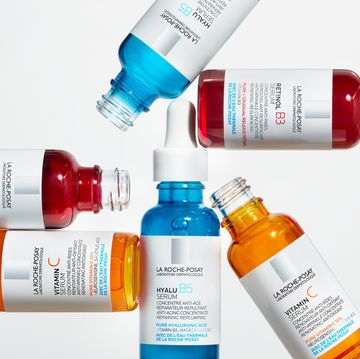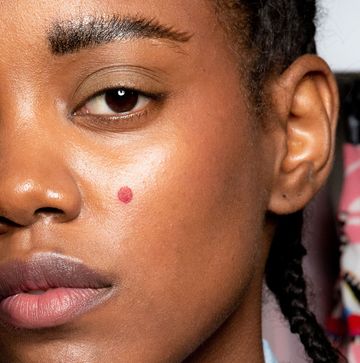Dry, scaly patches, rough splotches, red and inflamed welts—psoriasis can show up in a variety of ways and range in severity from mild and mostly manageable to severe and debilitating. But there’s at least one thing that most of the eight million Americans with the condition have in common: The elements of a beauty routine that most people take for granted are very complicated during a flare up.
“Psoriasis is predominantly a skin condition where skin cells rapidly turn over, creating thick and scaly patches or red plaques with a silvery scale,” explains Corey L. Hartman, M.D., founder of Skin Wellness Dermatology in Homewood, Alabama, and an assistant clinical professor of dermatology at the University of Alabama. Although it’s most common on elbows and knees, it can develop anywhere, including on the scalp and, in severe cases, all over the body. “No matter where psoriasis develops, skin is involved in our presentation to the world, so it takes a toll,” he says.
Unfortunately, experts aren’t sure what causes the chronic autoimmune inflammatory condition. Nor is there a cure. The good news: “We’ve come a long way in being able to treat psoriasis with targeted medications now that we know more about what’s involved in the immune process that triggers it,” Dr. Hartman says. And, while Rx treatments do the heavy lifting when it comes to managing psoriasis, a good skincare routine certainly helps, he adds. Here, the best tweaks to make to your routine, whether you’re dealing with an active flare-up or trying to avoid one.
Use shaving cream, a single or double blade-razor, and a careful hand for hair removal
If you have a very irritated psoriasis patch, shave around the area, giving a wide berth, until the flare is more under control. Going over it with a razor will just make the lesion worse, Dr. Hartman says. But for mild dry patches, you just want to avoid shaving over it multiple times with multiple blades, he says. Shaving cream is also a must; it helps prevent cuts and nicks and may head off what’s known as the Koebner phenomenon—when even minor trauma to skin (like a shaving nick) triggers the development of psoriasis or a psoriasis-like scaly patch.
Shampoo regularly with a salicylic acid shampoo
If you develop psoriasis patches on your scalp, wash your hair and scalp every or every other day with a shampoo that contains salicylic acid, which helps exfoliate flakes, soothe irritation and allow for topical medications to absorb better, Dr. Hartman says. “The best topical medications tend to be thick and oily, so I recommend applying those at night, then washing your hair in the morning,” he says.
When it comes to moisturizer, the thicker the better
“Psoriasis can manifest with very dry skin, so you want to use a thick, emollient moisturizer to help restore or maintain skin’s barrier,” Dr. Hartman says. In other words: Step away from lightweight lotions and gel-based products, some of which may actually contain drying alcohol. He recommends rich, fragrance-free creams or ointments that contain ceramides, which are the natural building blocks of skin’s barrier.
Soak up and seal in hydration
“I’m a bath guy,” Dr. Hartman says. “There’s no better way to soak in moisture and hydrate.” Moderation is key—as in, don’t steep so long your skin shrivels—but more important is being careful about what you put in your bath, he says. Opt for moisturizing, soothing, and fragrance-free oils or soothing oatmeal bath products, and avoid scented bath bombs and other perfumed products (fragrance is a known irritant) as well as bubbles (which can be harsh, drying detergents in disguise).
The secret to truly getting the most out of your bath is trapping in all that moisture you just soaked in. To do it, lightly pat skin with a towel when you get out (it should be damp, not dripping), then slather on your thick moisturizer.
Be smart about sun exposure
If you have psoriasis, you probably have heard that sun exposure may help reduce symptoms. (UV light can slow down the rapid turnover and buildup of skin cells.) But that shouldn’t be an invitation to go bake in the sun, which can increase your chance of skin cancer, Dr. Hartman says. “You shouldn’t get more than 10 to 15 minutes of unprotected sun exposure,” he explains, “because with psoriasis, there’s a disregulation of your immune system, which is similar to what happens in the development of skin cancer.”
In other words, if you sit in the sun to calm your psoriasis, you may be trading one skin condition for a far more dangerous one. A safer solution: Apply a mineral-based SPF (look for ingredients like zinc oxide and titanium dioxide), which can be less irritating than chemical sunscreen ingredients, and talk to your doctor about in-office phototherapy treatments or home devices. These deliver targeted and measured (i.e. less risky) doses of UV light.
Trade body scrubs for moisturizing washes
It might seem to make sense that you could simply exfoliate or scrub away the rough and scaly patches and buildup of skin cells, but that’s not the way psoriasis works. You may just end up further irritating skin and making it feel and look worse, Dr. Hartman says. Stick to soothing (and hydrating!) body wash instead.
Conceal like a pro
To camouflage small psoriasis patches on your face, along your hairline or anywhere else that’s visible, take a cue from the pros and opt for makeup brands specifically made for full, opaque coverage, such as Dermablend. Often used to cover tattoos on photo shoots or movie sets, Dermablend is thicker and contains much more pigment than traditional makeup, allowing for better coverage in fewer coats. That’s useful considering applying multiple layers of makeup can lead to cakiness, making the area look even more noticeable. Also opt for liquids rather than drying powders, prep the area by moisturizing first, and use a sponge to dab and blend.












